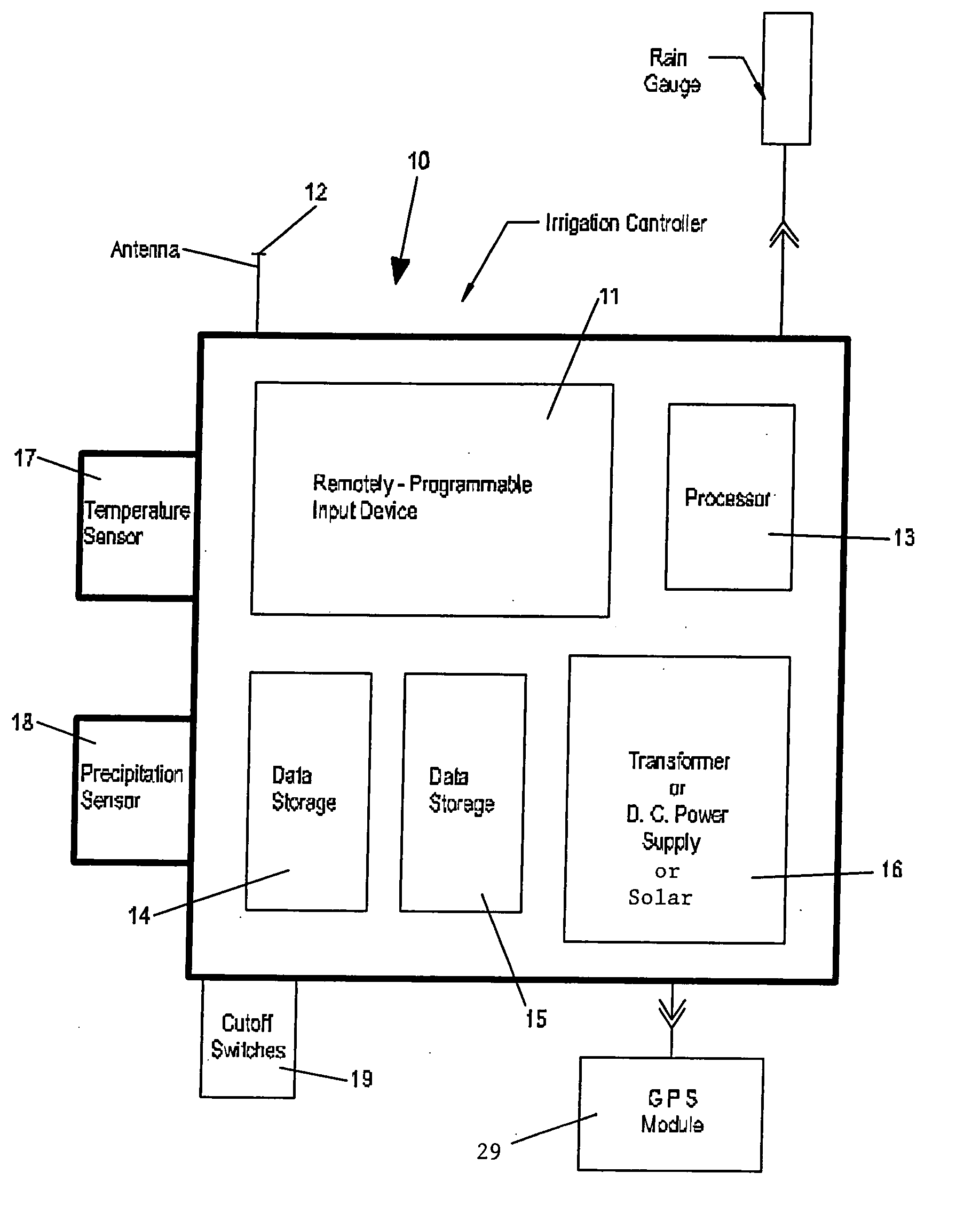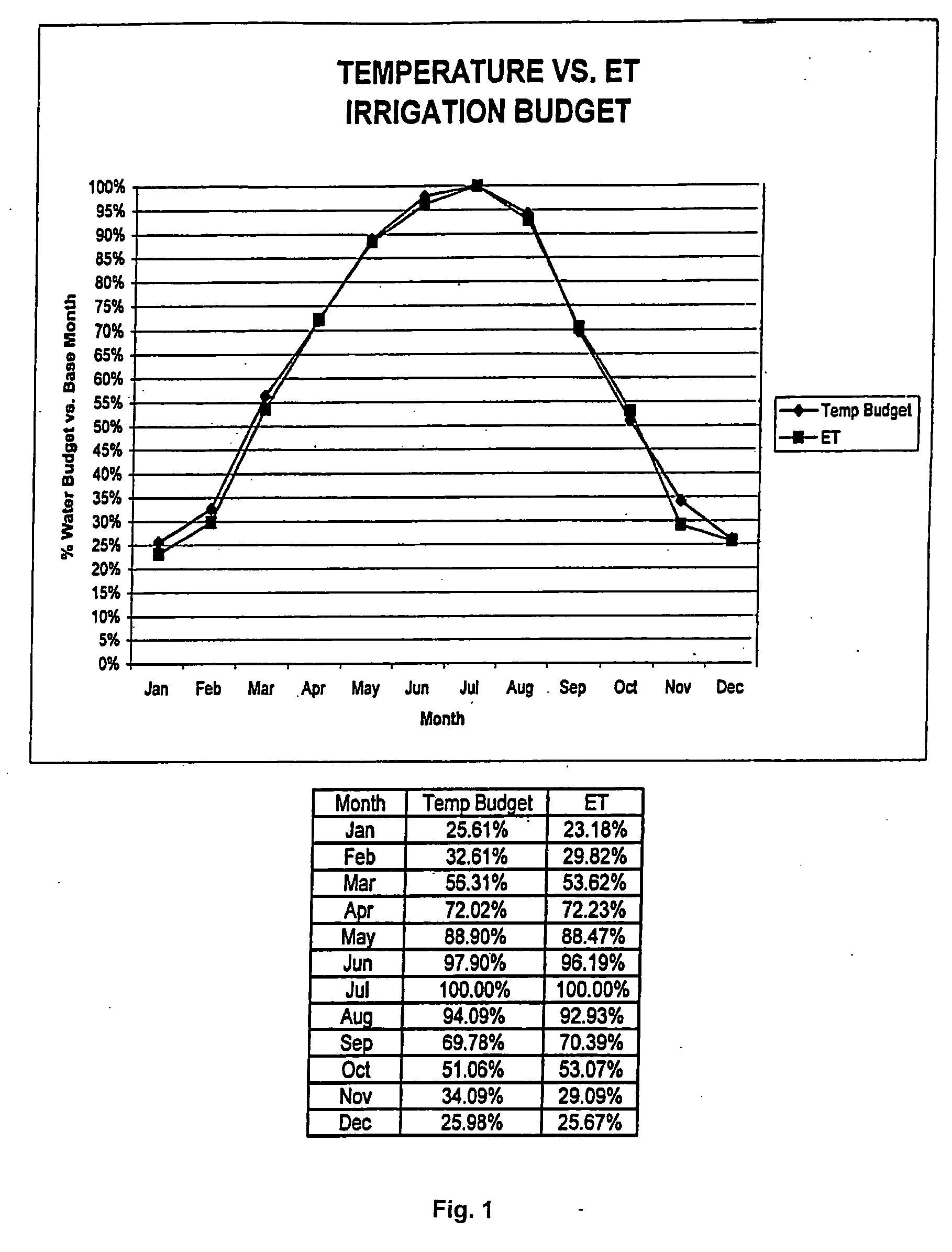Many regions of the United States lack sufficient
water resources to satisfy all of their competing agricultural, urban, commercial and environmental needs.
A significant portion of this projected shortage Was attributed to user
neglect and irrigation controller inefficiency.
It further estimated that approximately one-third of the
irrigation water was wasted, either due to inefficient irrigation systems or inadequate controller
programming, oftentimes due in part to complicated controller
programming procedures required of the operator.
This results in a total annual waste of 1.81 maf of water for California households alone.
Such water shortages have forced many municipalities to enact strict
water conservation measures.
However, there is no
consensus to date among these various consumers, water agencies, manufacturers, or state of federal government entities as to the most effective water conservation method or
automated control system.
The relatively high cost of labor in many municipalities further prohibits frequent manual adjustments of irrigation controllers.
This generally results in over-irrigation and runoff, particularly during the off-seasons, oftentimes by as much as one to two hundred percent.
Soil
moisture sensing devices and other methods of water conservation, have been available for decades, but have enjoyed only limited success.
However, regardless of the level of technology, such devices and methods are often problematic due to the location and number of sensors necessary to obtain accurate soil
moisture readings, the high costs of installing and maintaining the sensors, and the integrity and reliability of the sensors' data.
Unfortunately, methods incorporating ET formulas, and the installation, comprehension and
programming of controllers utilizing such methods, including those cited in the referenced patents above, are far too complex for the average user to understand and implement.
These programs have had limited effect and a short-term
impact.
Unfortunately, until now, these large landscape control systems have been far too complex and expensive for residential applications.”
The sheer number of variables renders ET theory difficult to explain, understand and apply, especially for an unsophisticated
consumer with little or no scientific or meteorological background.
Such unfamiliarity and complexity increase the margins of error already associated with the various ET formulas, further diminishing their effectiveness.
Water districts, irrigation consultants, manufacturers, the
Irrigation Association, the Center for
Irrigation Technology and other attendees at the EPA's Water Efficient Product Market Enhancement Program estimated that, due to the complexity, cost, impracticality of installation and difficulty in programming current irrigation controllers, less than one percent of all commercial and residential landscape irrigation systems currently and effectively utilize some form of the ET or
moisture sensing method.
Even if the ET or ground moisture sensing methods provided one hundred percent efficiency, which they do not, the limited adoption of these methods renders them an ineffective means of significant water conservation, since less than one percent of the runoff and water waste would be prevented under perfectly-efficient conditions.
Given the numerous microclimates existing within any one geographical area, data received from remotely located sensors may be inaccurate.
The data must also be received and processed in real-time, since average or historical ET data may be inaccurate during periods of unusual or excessive heat, cold, or rain, or other deviations from historical climate patterns.
Any inaccurate data would result in even greater ET deviations and inefficient irrigation.
ET measuring devices are generally also expensive to install and maintain.
The sensors and stations must also be powered in some manner—depending upon the particular geographic location,
AC power may not be readily available.
All of these considerations increase the cost of implementing an ET-based irrigation
system to a prohibitive level, and limit the widespread adoption of this method.
Some areas, such as street medians or parks, are not suitable for
weather station or sensor installation due to aesthetic reasons or the likelihood of vandalism.
Such information is not readily available to the average
consumer.
Unsurprisingly, such approaches have met with limited success.
The problem of irrigation mismanagement, and the main hurdle faced by these entities, can be simply summarized as follows: once a
system is properly designed, most of the wasted landscape
irrigation water and runoff is caused by not adjusting for daily, periodic, or seasonal changes.
If the summer schedule is assumed to be 100%, and November irrigation actually only requires, for example, about 20% of summer irrigation to satisfy the
vegetation needs, this means that as much as 80% of the water is wasted in the fall.
Such inaction is usually caused by the complexity and difficulty of determining the particular adjustment amounts and the significant inconvenience of daily adjustments.
However, this method is difficult to police because there are 500,000 customers in Clark County, Nev., so many users commonly violate these rules.
It is inconvenient for the homeowner, for example, to remember to change the watering schedule at least 4 times a year, particularly if they are not familiar with the programming of the controller.
 Login to View More
Login to View More  Login to View More
Login to View More 


